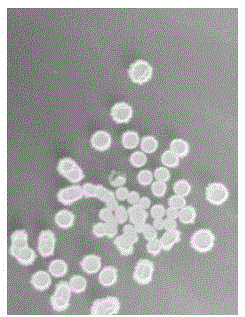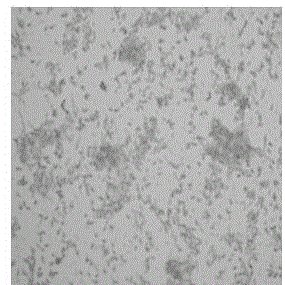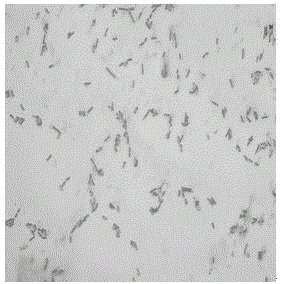Fibrinolytic-enzyme-producing Bacillus amyloliquefaciens strain separated from traditional fermented black beans
A technology of amylolytic spores and fibrinolytic enzymes, applied in the field of microorganisms and bioengineering, can solve the problems of easy bleeding, high price, high production cost, etc., and achieve the effects of good genetic stability, easy cultivation, and high production safety
- Summary
- Abstract
- Description
- Claims
- Application Information
AI Technical Summary
Problems solved by technology
Method used
Image
Examples
Embodiment 1
[0026] Embodiment 1: Preparation or screening of Bacillus amyloliquefaciens strain of the present invention
[0027] Step 1. Sample collection: collect fermented soybeans during the koji making process in the fermented soybean production factory, then seal them in sample bags and store them at low temperature.
[0028] Step 2. Enrichment culture: Take 1g of the sample in a sterilized test tube, add 9mL of sterile normal saline, seal it, shake it with a vortex oscillator for 5min, draw 1mL of the bacterial liquid and place it in a 30mL broth medium (according to the content of 100mL of water). Beef extract 0.5g, peptone 1g, sodium chloride 0.5g, agar 1.5g, pH 7.2-7.4) in a 250mL Erlenmeyer flask, and then placed in a shaker at 36-37°C, 200r / min for 72h.
[0029] Step 3. Primary screening of bacterial strains: using the plate dilution method, take 200 μL of the enriched and cultured bacterial solution and spread it on the sterilized skim milk powder screening medium (according t...
Embodiment 2
[0033] Embodiment 2: Microscopic morphology and molecular biological identification of Bacillus amyloliquefaciens strain of the present invention
[0034] Get the obtained bacterial strain Jxnuwx-1 and carry out microscopic morphology and molecular biology method identification, and specific process is as follows:
[0035] (1) The solid plate culture method is adopted: the solid culture is a broth medium, cultivated at 37±1°C for 24 hours, and the colony diameter is 3-6mm. White opaque colony, smooth surface, the same color on the opposite side, the edge of the colony is uplifted and regular serrated, with folds in the middle, and no pigment is produced on various media.
[0036] The microscopic morphological characteristics of Bacillus amyloliquefaciens are: the cells are short rods, the spores are elliptical, and the cells are mostly in pairs or chains. For the colony morphology of Bacillus amyloliquefaciens, see the attached figure 1 After staining with safranin and malac...
Embodiment 3
[0039] Embodiment 3: The implementation process of the 16S rDNA sequence analysis of the Bacillus amyloliquefaciens strain used for producing plasmin according to the present invention is as follows:
[0040] Primers were designed according to the most conserved sequence in bacterial 16S rDNA, wherein the forward primer was F: 5'-GAGAGTTTGATCCTGGCTCAG-3', and the reverse primer was R: 5'-AAGGAGGTGATCCAGCCGCA-3'. PCR reaction system 20μL. Thermal cycle parameters Pre-denaturation at 94°C for 5min, denaturation at 94°C for 30s, annealing at 55°C for 40s, extension at 72°C for 1.5min, 35 cycles, and extension at 72°C for 7min. The PCR product was detected by agarose gel electrophoresis, and the amplified product was a specific band with a size of about 1.4kb. The amplified sequence was sequenced, and the 16S rDNA nucleotide sequence of strain Jxnuwx-1 was 1451bp in size. The sequence was compared with the 16S rDNA nucleotide sequences of 10 strains in the GenBank database, and t...
PUM
| Property | Measurement | Unit |
|---|---|---|
| diameter | aaaaa | aaaaa |
Abstract
Description
Claims
Application Information
 Login to View More
Login to View More - R&D
- Intellectual Property
- Life Sciences
- Materials
- Tech Scout
- Unparalleled Data Quality
- Higher Quality Content
- 60% Fewer Hallucinations
Browse by: Latest US Patents, China's latest patents, Technical Efficacy Thesaurus, Application Domain, Technology Topic, Popular Technical Reports.
© 2025 PatSnap. All rights reserved.Legal|Privacy policy|Modern Slavery Act Transparency Statement|Sitemap|About US| Contact US: help@patsnap.com



